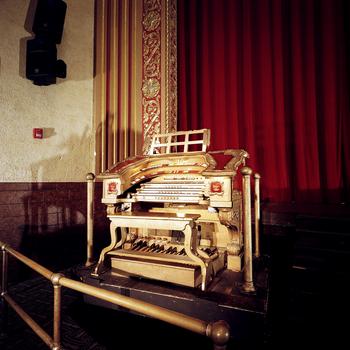How an organ saved the Michigan Theater

The exterior of the theater
photo by William Schumann, courtesy of the Michigan Theater
By Stephanie Kadel Taras
On Sunday, February 11, 1979, The Ann Arbor News published a lengthy article about the impending demise of the Michigan Theater. It was a farewell to the theater’s Barton organ, featuring interviews with local organists Newton Bates, Henry Aldridge, and Rupert Otto, who were still playing the organ at movie showings. “Aldridge has been going through what he describes as ‘terrible withdrawal symptoms’ at the thought of the theater’s closing,” wrote the reporter, Jane Myers. Otto said he had no reason to stay in Ann Arbor when he could no longer play the organ.
More than 30 years later, we know their worries were unnecessary. The Michigan Theater is more beautiful today than when it was built as a movie palace in 1928. Movies and concerts thrill audiences daily. And the Barton organ gets a regular workout by today’s local organists, who play five nights a week before the movie and accompany occasional silent films.
What happened after that premature newspaper eulogy to keep the Barton organ and the Michigan Theater from disappearing? There’s a clue in the last sentence of the article: “This morning the Motor City Theater Organ Society will hold its monthly open house at the Michigan Theatre and Donald Haller will present a two-hour concert beginning at 10 a.m.”
The “Second Sunday” organ concerts were a lifeline for the Michigan Theater, and the small group of locals who arranged those concerts are unsung heroes of today’s treasure on Liberty Street.
“We were a group of people who did what had to be done for the theater,” says Bob Hanley, 83.
Norm Horning, 87, agrees. “We just did what we saw was needed.”

The Barton organ
photo by William Schumann, courtesy of the Michigan Theater
What was needed, first and foremost, was to make sure the Barton Theatre Pipe Organ was still played and appreciated regularly. The organ was one of 7,000 installed in American movie houses between 1915 and 1930, and one of only 250 made by Barton Organ Company of Oshkosh, Wisconsin. It is now one of only 40 movie house organs still in its original location. The instrument was a gem, and those who loved it wanted everyone else to know it.
The Second Sunday concerts were free and open to the public and featured a single organist at each performance, including local luminaries Scott Smith (who maintains the organ today), John Lauter, Tony O’Brien, and Melissa Ambrose. The last two were just teenagers when they performed one of their first public organ concerts at the Second Sunday program. After the featured organist’s concert, the console was made available for anyone to sit down and play.
Norm tried playing the Michigan Theater organ once but remembers, “I didn’t know what I was doing.” Norm and his wife, Gena, and Bob and his wife, Bo, got involved in planning the Second Sunday concerts because they loved organ music. Although amateur organ players at home, they mostly just enjoyed the sound and fascinating mechanics of pipe organs.
The two couples met through the Motor City Theatre Organ Society, a chapter of the American Theatre Organ Society, which preserved organs at the Redford Theatre and other Detroit area theaters. The society restored the Michigan Theater organ in 1971, after it had been silent for years.
By the time Norm and Bob joined the society around 1978, the challenge was not to maintain the fine Barton organ but to retain it at all. The Michigan Theater’s operator, W.S. Butterfield Inc., had decided to stop showing movies. There was talk of converting the building into a food court and retail mall. Organ enthusiasts were despondent, but they hoped the Barton organ could at least be removed intact and installed somewhere else.
Meanwhile, Norm and Bob connected with organists Don Haller, Henry Aldridge, and Newton Bates and their wives, as well as organist Rupert Otto, organ repair expert Ben Levy, and a small handful of other volunteers (including Ruth and Howard Ralston, Dave and Jo Lau, Grant and Barb Cook, Bruce and Peg Amrine, and Jean Hicks) to make the best of an uncertain situation. (Note: Norm and Bob wanted to be sure to name the individuals who worked with them at the Michigan, and they apologize for any names they have omitted. “After all,” says Norm, “it’s been 30 years.”)
While most were members of the Motor City Theatre Organ Society, their work at the Michigan was not a Society-sponsored commitment. “Our group never had a name,” says Bob. They didn’t organize regular meetings or designate leaders or develop a budget. They just started to work.
With permission to host Second Sunday organ concerts, they got keys to the building and no resistance to whatever improvements they were inclined to make. “We would just show up and do something,” Bob remembers.
As a mechanical refrigeration expert at the University of Michigan, Bob couldn’t help but undertake repairs in the long-neglected facility. “The theater stunk of stale popcorn and old grease,” he remembers. He tore out the vent from the popcorn machine and found it was a “black blob of grease,” so he bought and installed a new vent and motor.
Then he tackled the central vacuum system. The old theater had a vacuum unit in the basement that connected to pipes in the walls. A vacuum hose could be hooked to the pipes at various locations in order to reach under all the theater seats. But no one knew the last time the vacuum bags had been emptied. When Bob opened the bale of bags in the basement, debris flew all over the room. “There must have been twenty years of peanuts and popcorn down there,” he laughs.
Norm was concerned about the pad that covered the organ when it wasn’t in use. The theater still hosted occasional live shows for which the organ was lowered below the stage and covered. Performers could dance and stomp right over the organ. So Norm and Bob built a plywood cover to provide extra protection. They also scraped and painted the dressing rooms behind the stage and cleaned the ticket booth and concession stand.
Of course, no amount of cleaning could restore the Michigan Theater to its former glory. Norm, who was 5 years old when the theater first opened, remembered going there with his parents, walking through the grand foyer with its gold leaf and chandeliers, and hearing the organ played during a silent movie. But in the 1950s, the ornate décor was covered over with a drab modern façade and drop ceilings.
“It wasn’t a palace anymore,” Bob remembers. He grew up in Detroit in the 1930s and went to the Fox Theatre as a child. “Those movie palaces meant something in the Depression,” he says. “A guy who was beating his brains out just to get enough to eat could walk into that theater for a dime and walk into another world.”
Recreating the movie palace experience was beyond the means of Norm and Bob and their friends, but little did they know their work was laying the foundation for doing just that. After several months of Second Sunday organ concerts, they began to host Monday night classic movies. They arranged to show the same movie that the Redford Theatre had rented over the weekend. Bo drove to Detroit’s Eastern Market for bags of cheap popcorn and ran the concession stand with Gena. Norm sold tickets.
They promoted their events with a sandwich board on the sidewalk and a monthly newsletter, “Notes from the Michigan,” that Bo produced and sent to a modest but growing mailing list. As word spread about the organ concerts, Second Sundays brought in more than 100 people each month.
After about a year, the small group got the attention of the mayor of Ann Arbor, Louis Belcher. He sat with them in the theater seats by the organ and told them, “We have got to save this theater.”
When the City Council took it up, Bo made an impassioned presentation on behalf of the group. Her speech helped sway the City Council to purchase the theater, which led to a voter-approved millage to pay the mortgage.
When a nonprofit board was established to govern the future of the Michigan Theater, Norm and Bob and their wives bowed out. “We didn’t want to be on the board,” says Bob. “We’re not politicians. We were the kind of people who get their hands dirty, who do a job just for the satisfaction of doing it.”
The group was particularly satisfied to have the American Theatre Organ Society include the Michigan Theater in its plans when the annual convention was held in Detroit 20 years ago. About 900 people came to Ann Arbor to hear the Barton organ played in its original location. The theater renovations were well under way, and, says Bob, “the organ sounded great!” After the concert, the visitors ate box lunches outside while the U-M bell tower carillon serenaded them.
Gena passed away a few months ago, but Norm still goes to the theater for the silent films with organ accompaniment. He thinks we have the organ to thank for saving the theater. “The organ is the main reason the Michigan Theater is still there,” he says. “It’s a good organ and was well worth saving.”
And it was those who cared about the organ who made the community care about the theater. Says Bob, “I don’t think the Michigan Theater would be there if not for us.”
Stephanie Kadel Taras is a professional writer in Ann Arbor who writes people's life stories through her company TimePieces Personal Biographies.


Comments
Speechless
Fri, Aug 13, 2010 : 8:42 p.m.
The saving of the theater a generation ago is the fortuitous story of the right people in the right place at the right time, all of them willing to invest the time and effort to act quickly before a point of no return was reached. A second life for a 50 year-old movie palace was hardly preordained by fate. It was not yet popular to rehabilitate aging theaters which dated to early in the century. And I'd generously give my heart to The Michigan and its successful organ activists, if the Secretary of State office hadn't already staked a future claim.
Kathleen
Fri, Aug 13, 2010 : 1:58 p.m.
I believe that the late Charlie Munz of Tobins Lake Studios was also among the restorers of the organ. When I worked there, Charlie used to tell stories of the Runnell Studio in Detroit, and the Theater Organ Society. Too bad I wasn't a better listener... K
Roger LeLievre
Fri, Aug 13, 2010 : 9:25 a.m.
I can't imagine Ann Arbor without the Michigan and I hope I never have to. Great story about an amazing effort. Thank you to everyone who helped save this beautiful landmark.
LA
Fri, Aug 13, 2010 : 8:39 a.m.
Thank you thank you organ lovers!! And thanks to A2.com for a nice story about hardworking caring people 'behind the scenes' who started the wonderful new life for our beautiful theater! (And we didn't need an organ transplant...)
Eric S
Fri, Aug 13, 2010 : 7:16 a.m.
"More than 30 years later, we know their worries were unnecessary." No, the theater is still there because enough people worried and acted on those worries. Their worries were very necessary.